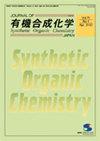卤素氧化作用下有机化合物的双官能化
IF 0.2
4区 化学
Q4 CHEMISTRY, ORGANIC
Journal of Synthetic Organic Chemistry Japan
Pub Date : 2023-10-01
DOI:10.5059/yukigoseikyokaishi.81.951
引用次数: 0
摘要
有机合成中的双官能团化是一种简便而有效的方法,可以同时在目标分子中选择性地引入两个不同的官能团。本文介绍了我们最近通过卤素氧化对保留双官能化和脱氢双官能化的研究。针对溴离子氧化脱氢双官能化反应,提出了脱烷基-氧化-溴化催化双官能化反应,同时溴离子有氧氧化裂解C-O键,得到α-溴酮。此外,还发现在好氧条件下,亚硝酸盐催化溴化氧化取代四氢吡喃的缩环反应可生成2-酰基四氢呋喃。我们还通过亚胺在吲哚基(苯基)碘亚胺上的1,3迁移,成功地实现了吲哚衍生物的区域选择性Csp2-Csp2溴胺化,并利用碘化试剂对2-甲基吲哚衍生物进行了Csp2-Csp3碘胺化,通过吲哚衍生物、双(磺酰基)亚胺和(二乙酰氧基)碘苯形成吲哚基(苯基)碘亚胺,获得了相应的卤氨基吲哚衍生物(III)。本文章由计算机程序翻译,如有差异,请以英文原文为准。
Dual Functionalization of Organic Compounds via Oxidation of Halogen
Dual functionalization in organic synthesis is an elegant and powerful method for simultaneously introducing two different functional groups regio-selectively into a target molecule. We herein describe our recent work on retained dual functionalization and dehydrogenative dual functionalization via oxidation of halogen. For the dehydrogenative dual functionalization by oxidation of bromide ion, a catalytic dual functionalization of ethers through dealkylation-oxidation-bromination accompanied by C-O bond cleavage via aerobic oxidation of bromide was developed to obtain α-bromo ketones. Furthermore, a nitrite-catalyzed ring-contraction reaction of substituted tetrahydropyrans by oxidation of bromide under aerobic conditions was discovered to provide 2-acyltetrahydrofurans. We also succeeded a regio-selective Csp2-Csp2 bromo-amination of indole derivatives via the 1,3-migration of imides on indolyl(phenyl)iodonium imides and a remote Csp2-Csp3 iodo-amination of 2-methyl indole derivatives with iodinating reagents to furnish the corresponding halo-amino-indole derivatives via formation of indolyl(phenyl)iodonium imides from indole derivatives, bis(sulfonyl)imides, and (diacetoxy)iodobenzene as the retained dual functionalization using hypervalent iodine (III).
求助全文
通过发布文献求助,成功后即可免费获取论文全文。
去求助
来源期刊
CiteScore
0.30
自引率
0.00%
发文量
120
审稿时长
6-12 weeks
期刊介绍:
Information not localized

 求助内容:
求助内容: 应助结果提醒方式:
应助结果提醒方式:


